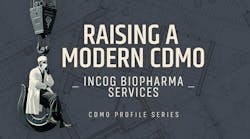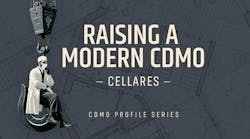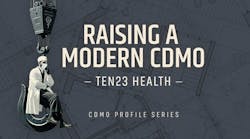When I got my first tattoo in college, I didn’t have any of the typical “first ink” worries (What if it hurts? What if I change my mind a year later? What will it look like when I’m OLD?) Nope. My biggest fear was the wrath of my mother once she saw it. I’m pretty sure I wore a bracelet on my wrist any time I was around my mom for a good five years after the fact, praying she wouldn’t notice.
Along those lines, perhaps you’ve noticed our cover art this month. My guess is it sticks out a bit in the pile of pharma publications on your desk.
The analogy came to me during a conversation with a tattoo artist friend. She was explaining to me how delicate and varied the relationship can be between an artist and client. Some clients come into tattoo shops knowing exactly what they want, outlined in detail. In essence, they approach tattoo artists with Requests for Proposals, looking for the best fit, quality and price.
Others clients come in less prepared — perhaps lacking experience or just plain indecisive. In these scenarios, it is the job of the artist to use his/her experience to guide the customer in the right direction. Communication, clarity and humility are key to building this relationship.
The former scenario — that of the very prepared and decisive customer — can also be a struggle. If that customer has a very clear vision for what they want, and the tattoo artist with years of experience sees flaws in the feasibility of that plan, it is up the artist to express that knowledgably and professionally, while also delicately balancing the “customer is always right” adage.
Of course, by no means should this somewhat alternative analogy detract from the seriousness of these outsourcing relationships in pharma. They are in fact critical. There is much at stake when you hand over important steps in the manufacturing and commercialization process to an outside party.
Drug manufacturers and contract organizations have shared successful, mutually beneficial relationships for decades. The contract services market has enjoyed healthy growth in recent years — no doubt a reflection of the robustness of pharmaceutical pipelines and the drug industry’s overall greater need for support. Industry surveys support that this trend will continue, which means fine-tuning the details of such relationships should be a priority.
For this month’s cover story, we spoke with prominent contract manufacturers to get an in-depth look at pharma’s outsourcing relationships from the CMO/CDMO perspective — what works, what doesn’t, and how to both build and maintain the optimum dynamic for continued success.
So please give it read and carefully consider what they have to say when it comes to outsourcing relationships and decisions...because when it comes to entrusting a third-party with your product, you don’t want regrets. No one wants to be that guy with the tattoo of his ex-girlfriend’s cat on his shoulder.





